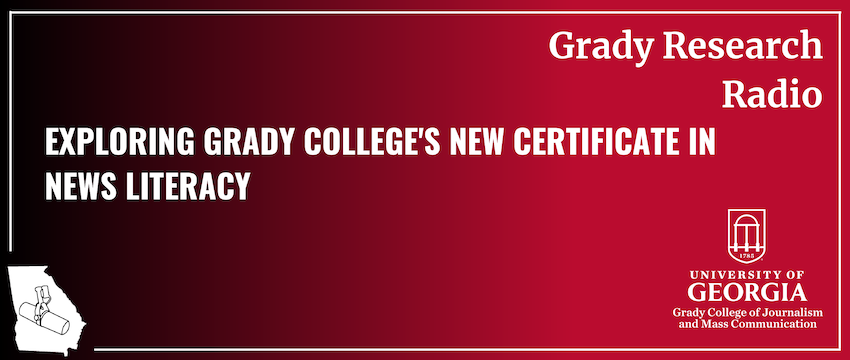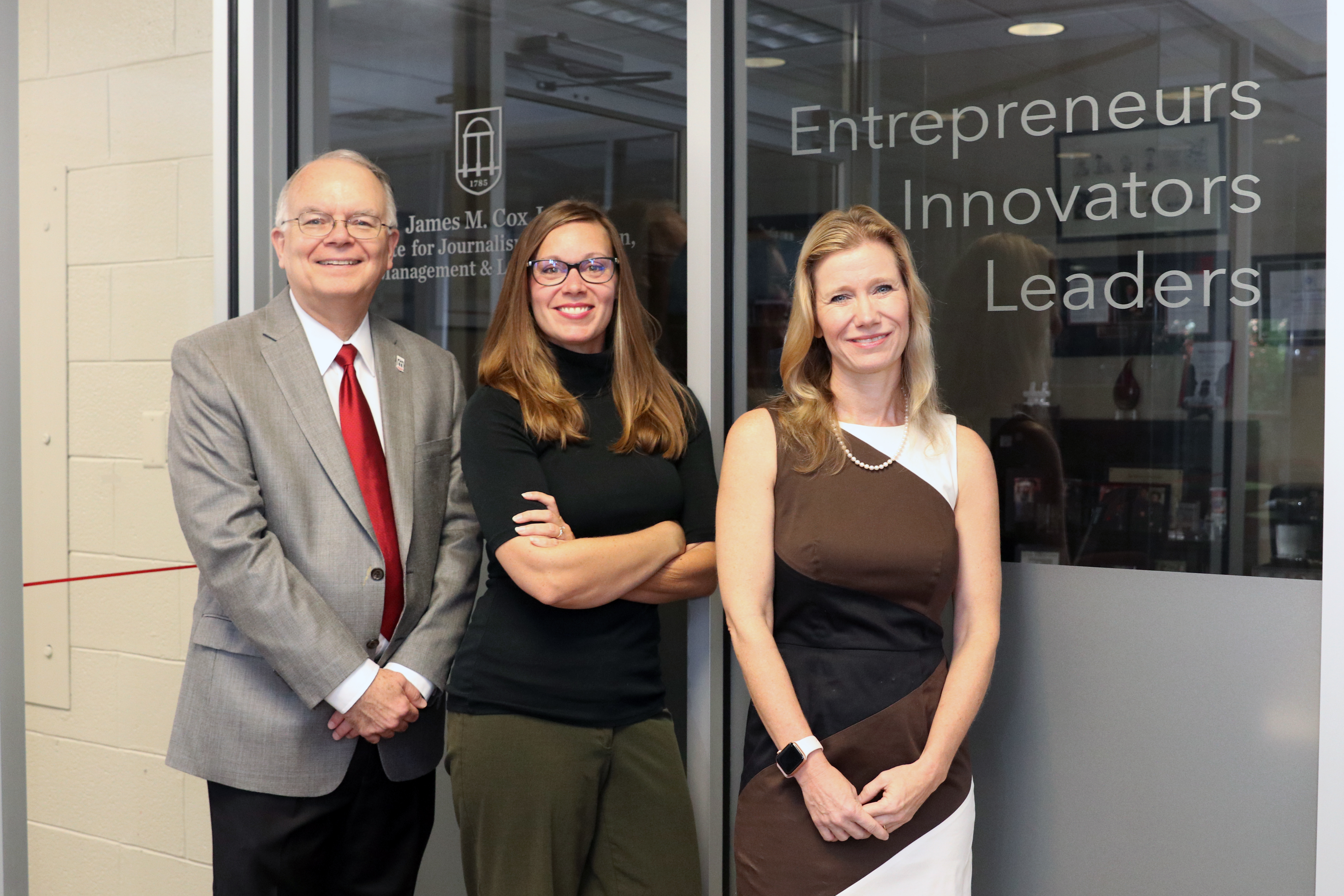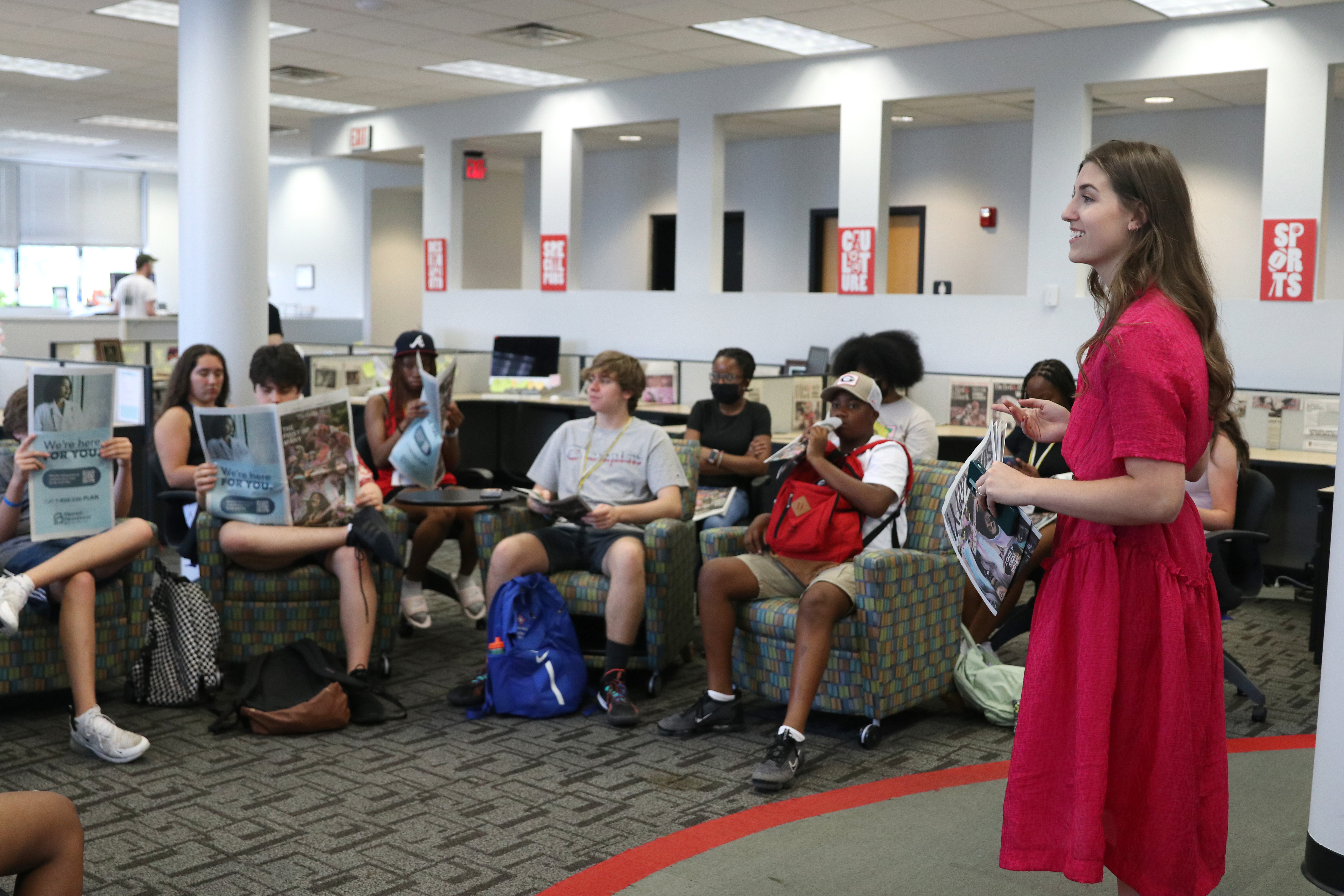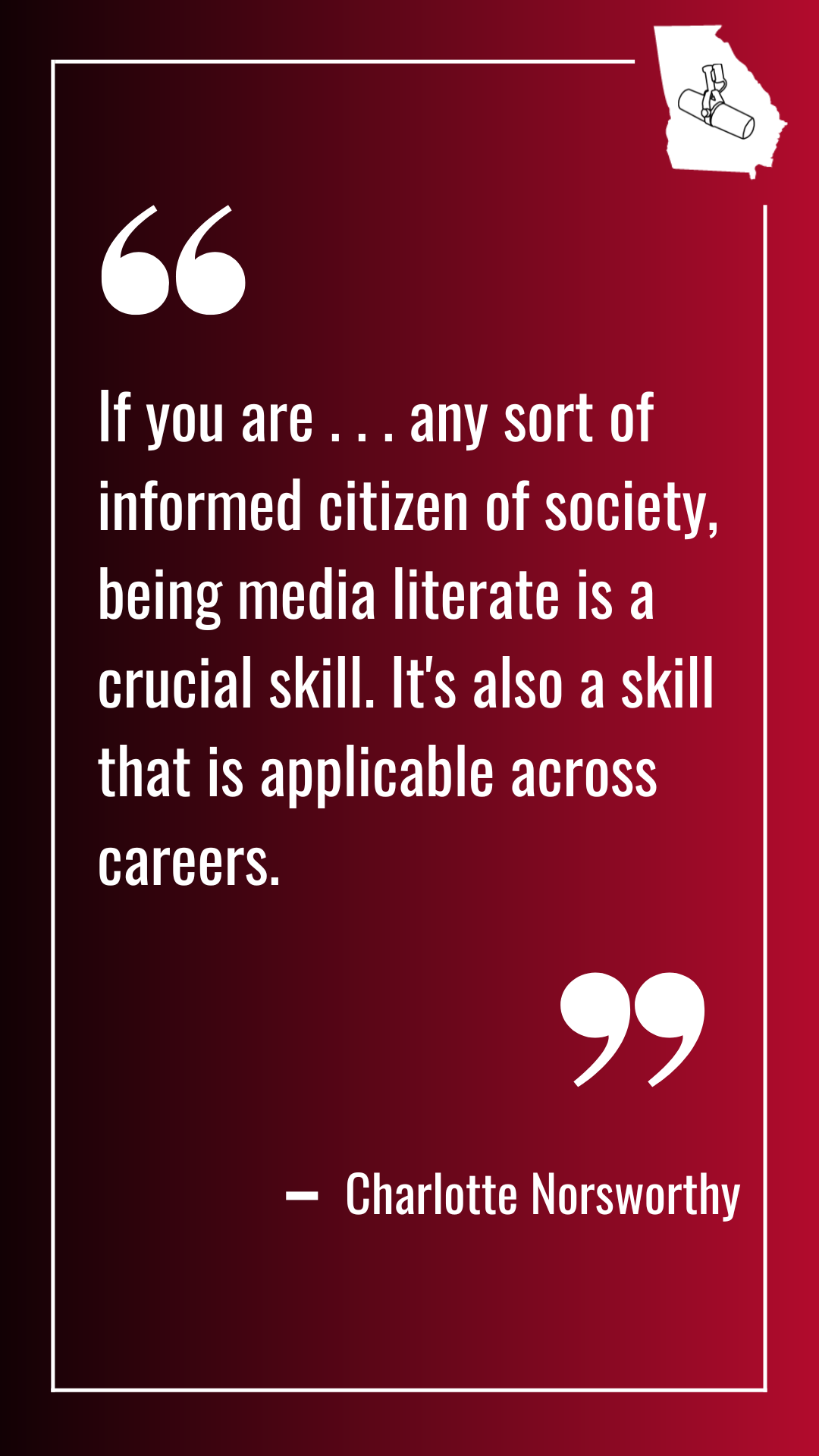Podcast: Exploring Grady’s new Certificate in News Literacy

Podcast: Exploring Grady’s new Certificate in News Literacy
Listen to Grady Research Radio
Apple Podcasts/Spotify/Stitcher
The current media landscape is full of unreliable and deceptive information, through deep fakes, click bait, conspiracies and more. With advancements in technology and the sheer amount of information out there, discerning between what is real and fake has perhaps never been more challenging.
With this issue in mind, Grady College’s James M. Cox Jr. Institute for Journalism Innovation, Management and Leadership has established the Certificate in News Literacy, open to any student at the University of Georgia. The program equips students with concepts and tools they need to recognize the difference between the truth and falsehoods.
To learn more about the program, including what courses are offered, what students gain, and how to get started, the Grady Research Radio podcast sat down with Dr. Keith Herndon, the executive director of the Cox Institute, the William S. Morris Chair in News Strategy and Management and director of the Cox Institute’s Certificate in News Literacy, and Charlotte Norsworthy, a part-time instructor at Grady College, the editorial director of The Red & Black, and the program coordinator for the Certificate in News Literacy.
Below is a transcript of the conversation, edited for clarity and brevity.
Grady Research Radio: Can you tell me what your roles are with the certificate program?

Keith Herndon: I am the executive director of the Cox Institute, and the certificate is an initiative of the Cox Institute. Specifically, as it relates to the certificate, I’m the director of the certificate.
Charlotte Norsworthy: And I’m the program coordinator. I help on the logistical side of things, making sure that students are enrolling properly, making it through the certificate, and being granted that certification at the end of the program. I’m also a part-time instructor at the university.
Grady Research Radio: Okay, great. Can you give me background on the certificate — its origins and why you determined there was a need to establish this certificate?
Keith Herndon: Well, I think that I started to sense a need for the certificate through some of the interactions I was having with students in the intro class, which we call JOUR 3030. The full title is Media News and Consumers. That course is open to any major on campus. We have a wide range of students in that class, ranging from finance majors to sport management to a wide range of Grady majors, including advertising, public relations, EMST and journalism.
When I started seeing the wide range of understanding of how the media actually operates and what we meant by this idea of misinformation and disinformation, it became pretty clear that there needed to be this broader approach to talking about news literacy with our broader student body.
Charlotte was my original TA when I took over teaching that class, and she also witnessed that firsthand. You can add something to that observation, right?

Charlotte Norsworthy: Absolutely. Students are coming at media from all different backgrounds, perspectives and contexts. How they were raised and socialized — all of that plays into how they engage with the media.
We realized, through doing that class, that they are also actively participating in the spread of information. And so, what is the quality of that information that they are engaging with and sharing by being active users in the digital space and on social media? It has a pretty hefty impact, and we were seeing that firsthand.
Keith Herndon: It was natural to use that course (JOUR 3030) as the intro for the certificate. That course explains what the First Amendment is, why it’s important and what it does and doesn’t do. That’s a really good, you know, foundational course to build a certificate around.
The certificate is based on four courses overall. There are two intermediate courses, which are our ethics and diversity class and our news credibility class. We end it with a capstone course that was developed by Dr. Amanda Bright called Digital Savvy.
Grady Research Radio: Can you kind of do a quick overview of some of the things one would learn in those courses?
Keith Herndon: The ethics and diversity class looks at how the news media operates internally. What are the things that the news media would consider conflicts of interest? How does the news media think about sourcing? We also want to think in terms of inclusivity. Are we covering our communities holistically? That’s where the diversity part comes in.
We also look at how our newsrooms operate in terms of making sure that we represent the communities that we cover. Do we have the right voices in our newsrooms? All those are part of the equation. So that’s what we mean by ethics and diversity. It’s more of an internal look at those kinds of issues.
The news credibility course is much more of an external look. That’s where we talk about this issue of trusting in news. How does the consumer interact with the news media? What are some of the key things that have affected trust in the media? What are some of the things that we have to address from political leanings? How do political leanings affect a person’s relationship with the news media? The news credibility course is looking at it more from an external perspective.
I already mentioned JOUR 3030. That’s the foundational class. It’s where we explain to people what misinformation and disinformation is — how we think of that as almost like pollution in our ecosystem, the same way we think of plastic as polluting the ocean. We really get into some of those fundamentals in that class.
And then it ends with the capstone course called Digital Savvy. That’s more of a practicum class, where the idea is, okay, how do we then spot false information? What are some tools that we can use to understand that this is not accurate information? This is not a photograph that depicts what it says it depicts. This is a video that’s not real. It’s been altered in some way.
Grady Research Radio: I know this is open to any student at the University of Georgia. So, can you talk a little bit about the train of thought, the reasons for opening it up to the entire campus? What would a student who isn’t directly involved in journalism on a day-to-day basis gain from this?

So, if you are, you know, any sort of informed citizen of society, being media literate is a crucial skill. It’s also a skill that is applicable across careers, right? So, in journalism, we are news gathering. We are creating news. We are producing and disseminating. So, it’s highly specialized and important to us in this field, as well as other Grady majors.
But majors across the university could also find themselves benefiting from it, because companies across the globe and across factions and fields and industries are also online. They’re also digital. They’re also engaging with information and producing the spread of information. So are they doing so in a way that’s accurate, that’s fair and balanced, that’s not polluting the ecosystem even more?
Grady Research Radio: Great. Are there any prerequisites for this certificate, or can a student start this freshman year?
Keith Herndon: The JOUR 3030 class has been designed from the very beginning to be open to any student at any point of their University of Georgia journey. We consider that to be an entry-level course. We have students in that class who take it in their freshman year, sometimes even their very first semester of their freshman year. We also have a group of sophomores who take it. Obviously that’s a required class if you’re a journalism major. It’s an elective for any other major.
That would be the way this would work. If it’s a journalism major that’s doing this certificate, all of the courses and the certificate would count for their major. If it’s a student outside of the journalism major and they do this certificate, it would count as a part of their electives.
Grady Research Radio: Okay, great. So, a journalism student, they could easily embed this into their schedule while not adding any time to their graduation schedule?
Keith Herndon: Yeah. That’s the way it works.
Grady Research Radio: For a student who’s in Grady, maybe in Advertising or Public Relations or Entertainment and Media Studies, how much time could this potentially add to their schedule?
Keith Herndon: I don’t think it would actually add anything if they’re building it in as part of their degree program. Most of the students in our College have plenty of room in their schedule for electives.
Now, they have to make some decisions. They wouldn’t be able to do a double major and a minor and another certificate and still do this as part of their normal course. I mean, it would be one of the things that they would have to choose as part of their degree program.
The journalism students, because this is part of their curriculum, can select these and it would just be embedded into their degree program. Others would have to figure out how to make it work within their body of electives that are available.
Grady Research Radio: Great. So you said there’s also a research component connected to this. Could you elaborate on that?
Keith Herndon: Charlotte and I are working with one of my teaching assistants, Kate Hester, who is one of my graduate assistants in the Cox Institute. And we’re looking at this idea that news literacy is essentially a critical thinking skill. It’s essentially something, as Charlotte alluded to, that all these different industries are looking at as almost a leadership attribute.
And so, we are doing some systematic review of literature, looking at the pedagogy that underlies the classes that we’re teaching, and then looking at how that pedagogy aligns with leadership education and other types of critical thinking training. We will document all of that. It’s called an innovative practice paper that we would then submit as a conference paper with the Association for Leadership Educators. Charlotte and I have collaborated on several of these types of pedagogy leadership framework papers in the past.
Anything you want to add to that process?
Charlotte Norsworthy: I think that the actual practice of going through and constructing these innovative practice papers is incredibly valuable to the research field.
Research typically deals with qualitative and quantitative research methods, and I think that these types of papers bridge the gap from the traditional academic methods into the practicum side of journalism, which is unique to our specific industry. You have to actually do the thing and then you can study the thing. So, this Certificate of News Literacy is sort of us doing the thing. But then we’re also reviewing how it’s impacting those themes that Keith mentioned.
Keith Herndon: And so I think that a lot of what we do in the Cox Institute, you know, our full name is the Cox Institute for Journalism, Innovation, Management and Leadership. So we think that the certificate is innovative, but we also think it has a component of leadership embedded in it. A key attribute of being a leader, in my estimation, is to be truthful and to be trustworthy.
The idea that we have to think of it in terms of the things that we share on social media, the things that we produce out there in the world — it goes beyond just journalism production. It’s anything we do on social media. Are we sharing a post? Are we liking something that may not even be remotely accurate? But the very act of liking it has put it out in your information dissemination.
We want students to think, “Well, is that putting me in the best light?” That’s learning to be discerning about how you live your life. And that’s a critical thinking skill. That critical thinking skill of how we look at all of this information, that is definitely a leadership attribute.
Through this research, we’re trying to look at leadership theories, some critical thinking frameworks, and how other industries might approach similar types of training. We want to document all that and see how it comes together.
We’re at the very beginning of putting together this research material. So check back in with us this time next year and we’ll have a little bit better of an understanding of how it all came together. But we’re really excited about that aspect of it. We’re also excited about bringing in one of our top graduate students to help us with that project as well.
Grady Research Radio: Great, so to wrap up here, what if a student wants to embed this certificate program in their schedules? How can they go about doing that?
Charlotte Norsworthy: The best thing to do is to first talk with your advisor and make sure the 12-hour program that it takes to complete the certificate is manageable and doable with the goals that you have based on your majors, minors and certificates that you may be balancing on top of this program. I would definitely advise you to talk with your academic advisor and make sure that that’s going to work
I would then say, when you’re on Athena, whenever you’re establishing your majors and your minors, you can also click the drop down and add the Certificate of News Literacy as your certificate to formally establish that.
After you do that, we’re notified of that formal enrollment and you can start taking your courses starting with JOUR 3030 and work your way through the program from there.
Keith Herndon: Right. I do want to emphasize one thing that this is different from some certificate programs at the university. It is open enrollment. There’s no application process for our certificate. It’s four courses and all of the courses are always available. There are plenty of seats. There’s no need to have an application process.
We want to make this simple and easy for any student that has an interest in learning about the news media, news literacy, understanding the leadership attributes around that, and understanding its importance.
All they have to do is go to Athena and enroll. So as long as you’re a student in good standing at the university, then you can do the certificate. We’re really excited about that.
We’re in the process now of meeting with advisors at the various colleges and talking about it in classes. We’ve built out a website as part of the Cox Institute so that there’s more information out there. Charlotte has put together a really robust frequently asked questions page. So, you know, anybody can find the information they’re looking for. But it’s an enrollment, as opposed to an application, certificate.
Charlotte Norsworthy: And it’s a do-it-at-your-own-pace kind of program, which I think is also unique to other certificates. You don’t have to complete it within a semester or a series of semesters.
There’s a specific order that you take the courses in. But if you start with JOUR 3030 your first semester freshman year, you can wait until your senior year to finish up the three courses if that’s the only space in time that you’ll have.
We’ve set it up so that it does have an intro course. There are two intermediate courses. Those can be taken in any order. We do prefer that you take the JOUR 3030 Media News and Consumers first. But then you can take News Credibility or Journalism Ethics and Diversity in either order. Once you’ve completed those, you finish it up with the capstone, the Digital Savvy course.
Grady Research Radio: Great. Well, thank you both for your time here today.
Charlotte Norsworthy: Thanks for having us.
Keith Herndon: Yeah. Thanks a lot.